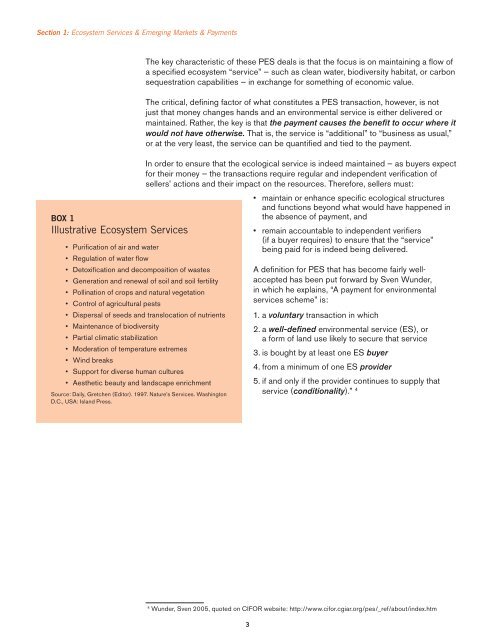Payments for Ecosystem Services: Getting Started. A Primer - UNEP
Payments for Ecosystem Services: Getting Started. A Primer - UNEP
Payments for Ecosystem Services: Getting Started. A Primer - UNEP
You also want an ePaper? Increase the reach of your titles
YUMPU automatically turns print PDFs into web optimized ePapers that Google loves.
Section 1: <strong>Ecosystem</strong> <strong>Services</strong> & Emerging Markets & <strong>Payments</strong><br />
BOX 1<br />
Illustrative <strong>Ecosystem</strong> <strong>Services</strong><br />
The key characteristic of these PES deals is that the focus is on maintaining a fl ow of<br />
a specifi ed ecosystem “service” — such as clean water, biodiversity habitat, or carbon<br />
sequestration capabilities — in exchange <strong>for</strong> something of economic value.<br />
The critical, defi ning factor of what constitutes a PES transaction, however, is not<br />
just that money changes hands and an environmental service is either delivered or<br />
maintained. Rather, the key is that the payment causes the benefit to occur where it<br />
would not have otherwise. That is, the service is “additional” to “business as usual,”<br />
or at the very least, the service can be quantifi ed and tied to the payment.<br />
In order to ensure that the ecological service is indeed maintained — as buyers expect<br />
<strong>for</strong> their money — the transactions require regular and independent verifi cation of<br />
sellers’ actions and their impact on the resources. There<strong>for</strong>e, sellers must:<br />
• Purifi cation of air and water<br />
• Regulation of water fl ow<br />
• Detoxifi cation and decomposition of wastes<br />
• Generation and renewal of soil and soil fertility<br />
• Pollination of crops and natural vegetation<br />
• Control of agricultural pests<br />
• Dispersal of seeds and translocation of nutrients<br />
• Maintenance of biodiversity<br />
• Partial climatic stabilization<br />
• Moderation of temperature extremes<br />
• Wind breaks<br />
• Support <strong>for</strong> diverse human cultures<br />
• Aesthetic beauty and landscape enrichment<br />
Source: Daily, Gretchen (Editor). 1997. Nature’s <strong>Services</strong>. Washington<br />
D.C., USA: Island Press.<br />
• maintain or enhance specifi c ecological structures<br />
and functions beyond what would have happened in<br />
the absence of payment, and<br />
• remain accountable to independent verifi ers<br />
(if a buyer requires) to ensure that the “service”<br />
being paid <strong>for</strong> is indeed being delivered.<br />
A defi nition <strong>for</strong> PES that has become fairly wellaccepted<br />
has been put <strong>for</strong>ward by Sven Wunder,<br />
in which he explains, “A payment <strong>for</strong> environmental<br />
services scheme” is:<br />
1. a voluntary transaction in which<br />
2. a well-defined environmental service (ES), or<br />
a <strong>for</strong>m of land use likely to secure that service<br />
3. is bought by at least one ES buyer<br />
4. from a minimum of one ES provider<br />
5. if and only if the provider continues to supply that<br />
service (conditionality).” 4<br />
4<br />
Wunder, Sven 2005, quoted on CIFOR website: http://www.ci<strong>for</strong>.cgiar.org/pes/_ref/about/index.htm<br />
3
















